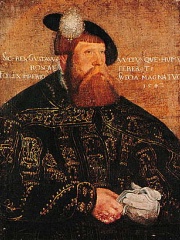
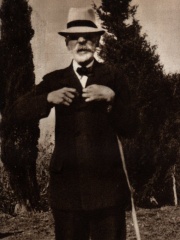
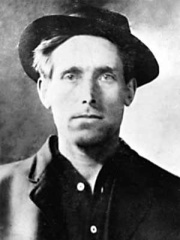
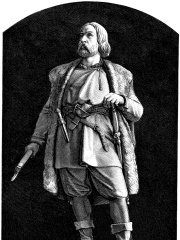

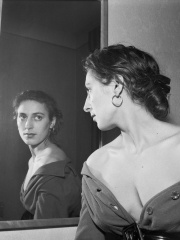
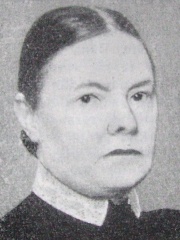
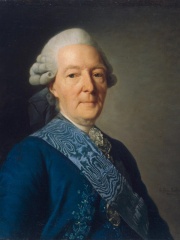
The Most Famous
SOCIAL ACTIVISTS from Sweden
This page contains a list of the greatest Swedish Social Activists. The pantheon dataset contains 840 Social Activists, 11 of which were born in Sweden. This makes Sweden the birth place of the 19th most number of Social Activists behind Afghanistan, and Egypt.
Top 10
The following people are considered by Pantheon to be the top 10 most legendary Swedish Social Activists of all time. This list of famous Swedish Social Activists is sorted by HPI (Historical Popularity Index), a metric that aggregates information on a biography's online popularity. Visit the rankings page to view the entire list of Swedish Social Activists.

1. Gustav I of Sweden (1496 - 1560)
With an HPI of 78.75, Gustav I of Sweden is the most famous Swedish Social Activist. His biography has been translated into 68 different languages on wikipedia.
Gustav Eriksson Vasa (12 May 1496 – 29 September 1560), also known as Gustav I, was King of Sweden from 1523 until his death in 1560. He was previously self-recognised Protector of the Realm (Riksföreståndare) from 1521, during the Swedish War of Liberation against King Christian II of Denmark, Norway and Sweden. Gustav rose to lead this war following the Stockholm Bloodbath, where his father was executed. Gustav's election as king on 6 June 1523 (the future National Day of Sweden) and his triumphant entry into Stockholm eleven days later marked Sweden's final secession from the Kalmar Union. During his reign, Gustav initiated the Protestant reformation in Sweden, transformed the country from an elective to a hereditary monarchy and established a standing army and navy.

2. Axel Munthe (1857 - 1949)
With an HPI of 70.59, Axel Munthe is the 2nd most famous Swedish Social Activist. His biography has been translated into 34 different languages.
Axel Martin Fredrik Munthe (31 October 1857 – 11 February 1949) was a Swedish-born physician and psychiatrist, best known as the author of The Story of San Michele, an autobiographical account of his life and work. He spoke several languages (Swedish, English, French, Italian fluently, and German at least passably), grew up in Sweden, attended medical school there, then studied medicine in Paris and opened his first practice in France. He was married to a wealthy Englishwoman and spent most of his adult life in Italy. His philanthropic nature often led him to treat the poor without charge, and he risked his life on several occasions to offer medical help in times of war, disaster or plague. As an advocate of animal rights, he purchased land to create a bird sanctuary near his home in Italy, argued for bans on painful traps, and himself kept pets as diverse as an owl and a baboon, as well as many types of dog. His writing is light-hearted, being primarily memoirs drawn from his real-life experiences, but it is often tinged with sadness or tragedy, and often uses dramatic licence. He primarily wrote about people and their idiosyncrasies, portraying the foibles of both the rich and the poor, but also about animals.

3. Joe Hill (1879 - 1915)
With an HPI of 66.17, Joe Hill is the 3rd most famous Swedish Social Activist. His biography has been translated into 28 different languages.
Joe Hill (born Joel Emmanuel Hägglund; October 7, 1879 – November 19, 1915) was a Swedish-American labor activist, songwriter, and member of the Industrial Workers of the World (IWW, familiarly called the "Wobblies"). A native Swedish speaker, he learned English during the early 1900s, while working various jobs from New York to San Francisco. Hill, an immigrant worker frequently facing unemployment and underemployment, became a popular songwriter and cartoonist for the union. His songs include "The Preacher and the Slave" (in which he coined the phrase "pie in the sky"), "The Tramp", "There Is Power in a Union", "The Rebel Girl", and "Casey Jones—the Union Scab", which express the harsh and combative life of itinerant workers, and call for workers to organize their efforts to improve working conditions. In 1914, John G. Morrison, a Salt Lake City area grocer and former policeman, and his son were shot and killed by two men. The same evening, Hill arrived at a doctor's office with a gunshot wound, and briefly mentioned a fight over a woman. He refused to explain further, even after he was accused of the grocery store murders on the basis of his injury. Hill was convicted of the murders in a controversial trial. Following an unsuccessful appeal, political debates, and international calls for clemency from high-profile figures and workers' organizations, Hill was executed in November 1915. After his death, he was memorialized by several folk songs. His life and death have inspired books and poetry. The identity of the woman and the rival who supposedly caused Hill's injury, though frequently speculated upon, remained mostly conjecture for nearly a century. William M. Adler's 2011 biography of Hill presents information about a possible alibi, which was never introduced at the trial. According to Adler, Hill and his friend and countryman Otto Appelquist were rivals for the attention of 20-year-old Hilda Erickson, a member of the family with whom the two men were lodging. In a recently discovered letter, Erickson confirmed her relationship with the two men and the rivalry between them. The letter indicates that when she first discovered Hill was injured, he explained to her that Appelquist had shot him, apparently out of jealousy.

4. Engelbrekt Engelbrektsson (1390 - 1436)
With an HPI of 65.34, Engelbrekt Engelbrektsson is the 4th most famous Swedish Social Activist. His biography has been translated into 27 different languages.
Engelbrekt Engelbrektsson (1390s – 4 May 1436) was a Swedish nobleman, rebel leader and military leader of German ancestry. He was the leader of the Engelbrekt rebellion in 1434 against Eric of Pomerania, king of the Kalmar Union.
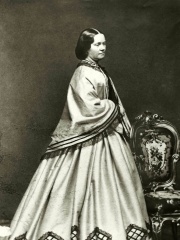
5. Sophie Adlersparre (1823 - 1895)
With an HPI of 62.40, Sophie Adlersparre is the 5th most famous Swedish Social Activist. Her biography has been translated into 28 different languages.
Carin Sophie Adlersparre (née Leijonhufvud; 6 July 1823 – 27 June 1895), known by her pen-name Esselde, was a Swedish feminist, writer and publisher who was one of the pioneers of the 19th-century women's rights movement in Sweden. She was the founder and editor of the first women's magazine in Scandinavia, Home Review (Tidskrift för hemmet), in 1859–1885; co-founder of Friends of Handicraft (Handarbetets vänner) in 1874–1887; founder of the Fredrika Bremer Association (Fredrika-Bremer-förbundet) in 1884; and one of the first two women to be a member of a state committee in Sweden in 1885.

6. Greta Thunberg (b. 2003)
With an HPI of 60.67, Greta Thunberg is the 6th most famous Swedish Social Activist. Her biography has been translated into 118 different languages.
Greta Tintin Eleonora Ernman Thunberg (Swedish: [ˈɡrêːta ˈtʉ̂ːnbærj] ; born 3 January 2003) is a Swedish activist best known for pressuring governments to address climate change and social issues. She gained global attention in 2018, at age 15, after starting a solo school strike outside the Swedish parliament, which inspired the worldwide Fridays for Future movement. She has since broadened her focus to include human rights and global justice, voicing support for Ukraine, Palestine and Armenia. In 2025, Thunberg twice joined a humanitarian flotilla bound for the Gaza Strip. Thunberg has been credited with sparking the "Greta effect", influencing environmental awareness and youth engagement worldwide. She has received numerous honours, including inclusion in Time's 100 Most Influential People and being named Person of the Year in 2019.

7. Katarina Taikon (1932 - 1995)
With an HPI of 60.34, Katarina Taikon is the 7th most famous Swedish Social Activist. Her biography has been translated into 29 different languages.
Katarina Taikon-Langhammer (29 July 1932 – 30 December 1995) was a Swedish Romani activist, leader in the civil rights movement, writer and actor, from the Kalderash sub group. She was the sister of Rosa Taikon. She has been called the Martin Luther King of Sweden.

8. Gertrud Adelborg (1853 - 1942)
With an HPI of 56.09, Gertrud Adelborg is the 8th most famous Swedish Social Activist. Her biography has been translated into 21 different languages.
Gertrud Virginia Adelborg (10 September 1853 – 25 January 1942) was a Swedish teacher, feminist and leading member of the women's rights movement.

9. Ivan Betskoy (1704 - 1795)
With an HPI of 54.98, Ivan Betskoy is the 9th most famous Swedish Social Activist. His biography has been translated into 15 different languages.
Ivan Ivanovich Betskoy or Betskoi (Russian: Ива́н Ива́нович Бецко́й; 14 February [O.S. 3 February] 1704 – 11 September [O.S. 31 August] 1795) was a Russian statesman and figure of the Russian Enlightenment. He was educational reformer who served as Catherine II's advisor on education and as president of the Imperial Academy of Arts for from 1764 to 1794. Perhaps the crowning achievement of his long career was the establishment of Russia's first unified system of public education.
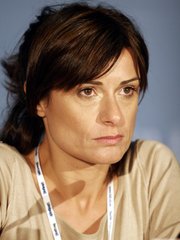
10. Biljana Srbljanović (b. 1970)
With an HPI of 46.34, Biljana Srbljanović is the 10th most famous Swedish Social Activist. Her biography has been translated into 16 different languages.
Biljana Srbljanović (Serbian Cyrillic: Биљана Србљановић, pronounced [bǐʎana sr̩bʎǎːnoʋitɕ]; born 15 October 1970) is a Serbian playwright and university professor. She has written eleven theater plays and screenplay for Otvorena vrata television series that aired on Radio Television of Serbia during the mid-1990s. Her plays have been staged in some 50 countries. Srbljanović is also a part-time lecturer at the University of Arts' Faculty of Dramatic Arts (FDU) in Belgrade. On 1 December 1999, she became the first non-German writer to receive the Ernst Toller Prize. She is the recipient of various theatre awards in Serbia, including the Dragiša Kašiković Award, Slobodan Selenić Award, City of Belgrade Award, Joakim Vujić Statuette, and Sterija Award. Furthermore, she received the 2003 Osvajanje slobode Award, an annual accolade given out by the Serbian Civic Alliance (GSS) political party to women for "contributions in promotion of human rights, democracy, and tolerance in political communication". In 2007, she was awarded the IX Europe Prize Theatrical Realities, in Thessaloniki.
People
Pantheon has 11 people classified as Swedish social activists born between 1390 and 2003. Of these 11, 3 (27.27%) of them are still alive today. The most famous living Swedish social activists include Greta Thunberg, Biljana Srbljanović, and Isabelle Axelsson. The most famous deceased Swedish social activists include Gustav I of Sweden, Axel Munthe, and Joe Hill. As of April 2024, 1 new Swedish social activists have been added to Pantheon including Biljana Srbljanović.
Living Swedish Social Activists
Go to all RankingsGreta Thunberg
2003 - Present
HPI: 60.67
Biljana Srbljanović
1970 - Present
HPI: 46.34
Isabelle Axelsson
2001 - Present
HPI: 32.64
Deceased Swedish Social Activists
Go to all RankingsGustav I of Sweden
1496 - 1560
HPI: 78.75
Axel Munthe
1857 - 1949
HPI: 70.59
Joe Hill
1879 - 1915
HPI: 66.17
Engelbrekt Engelbrektsson
1390 - 1436
HPI: 65.34
Sophie Adlersparre
1823 - 1895
HPI: 62.40
Katarina Taikon
1932 - 1995
HPI: 60.34
Gertrud Adelborg
1853 - 1942
HPI: 56.09
Ivan Betskoy
1704 - 1795
HPI: 54.98
Newly Added Swedish Social Activists (2025)
Go to all RankingsOverlapping Lives
Which Social Activists were alive at the same time? This visualization shows the lifespans of the 5 most globally memorable Social Activists since 1700.


